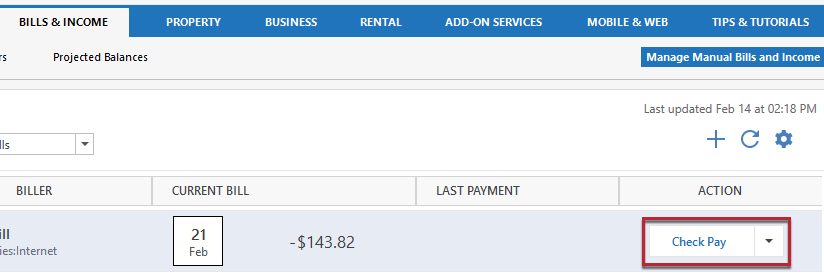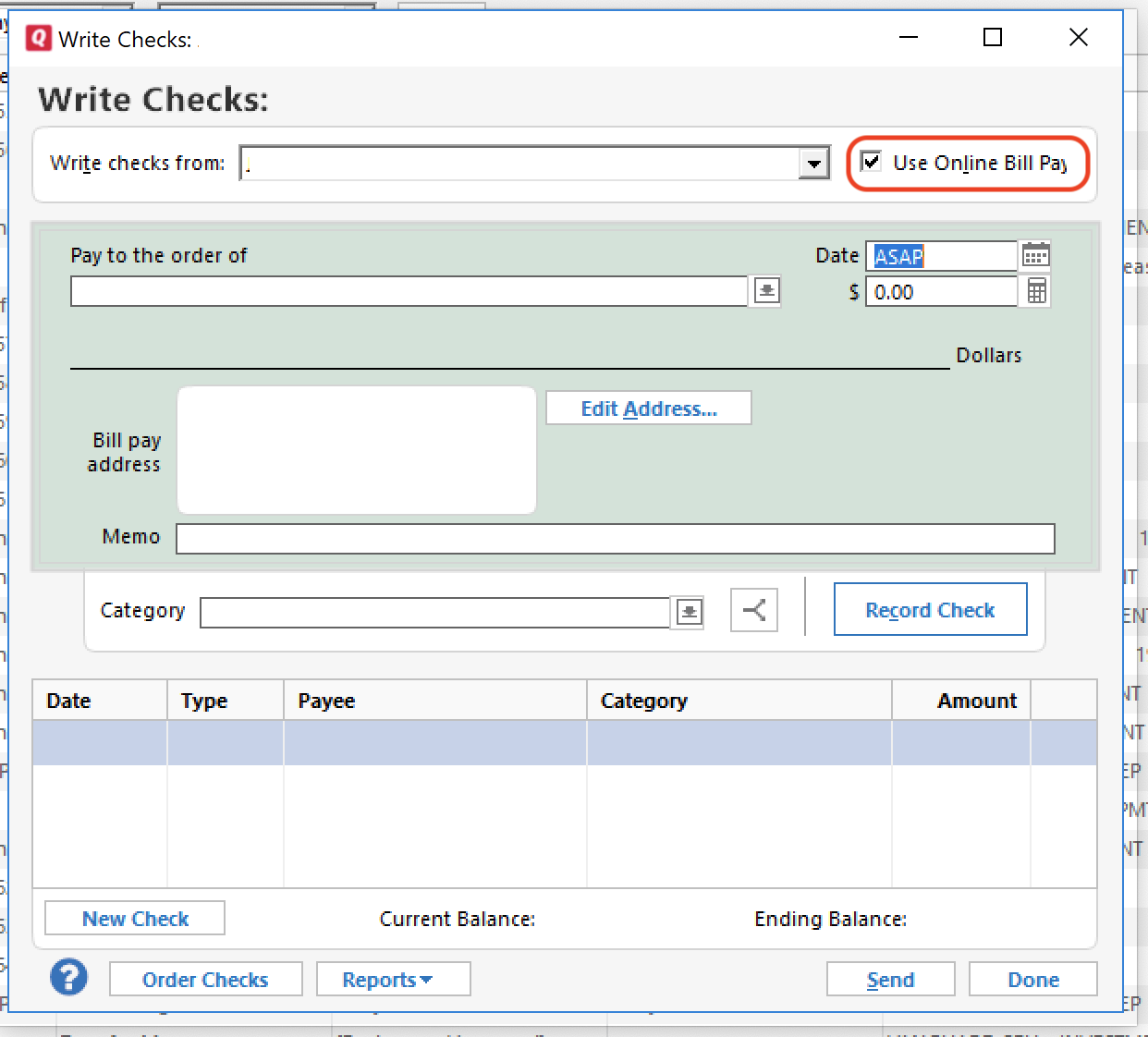To do payroll in Quicken 2013 or 2014, you need to set up a couple of payroll expense categories. Fortunately, doing so is not particularly difficult. This information is specific to setting up U.S. federal income and payroll taxes.
- How To Input Pay Stub In Quicken For Mac Free
- How To Input Pay Stub In Quicken For Mac 2020
- How To Input Pay Stub In Quicken For Mac Download
If you employ people in a state that has a state income tax — California, say — you may also have to deal with state payroll taxes. But you can track and process these the same way you process the federal taxes. (Some counties and cities even have income taxes, but these should also work the same way.)
Set up the wages expense category
Nate Phillips has been using Quicken and TurboTax for almost 20 years. He has spent part of that time as a Quicken beta tester, helping identify bugs and annoyances with Quicken updates before they are released. Nate holds a master’s degree in Computer Science and has numerous technology certifications. Pay From Account: By default, Quicken will use the account that you enabled for Check Pay. If you have more than one account, you can choose another Check Pay enabled account. You can optionally enter information for the Category, Tag, and Memo fields. Adding this information will improve Quicken reports about your payments and transactions. Due to Quicken only doing 1-year memberships (used to be 3 years) I had to renew my service and per Quicken it was only allowing it at full price for existing customers. Well, I took a gamble and bought this at BB on sale and use the code to extend my membership a year. I'm very pleased. So you don't have to pay full at Quicken. I'd like to track on on Pay Check setup on Quicken what employer pays for. There is an option to add pre-tax deductions, but those are my portions that I have to pay.

How To Input Pay Stub In Quicken For Mac Free
You need to set up a payroll expense category for tracking the wages you pay employees:
Choose Tools→Category List.
Quicken, with no hesitation, displays the Category List window.
Click the New button.
Quicken displays the Set Up Category dialog box.
Enter Wages as the category name by moving the cursor to the Category Name text box and typing Wages.
If you told Quicken during the setup that you’ll use Quicken to track a business, Quicken may have automatically set up the Wages category.
(Optional) Enter a description of the category.
If you want, you can type a description in the Description text box.
Select the Expense option button.
This choice tells Quicken that you’re setting up an expense category.
(Optional) Describe the tax characteristics of this category.
To further describe taxable income and tax deduction categories, click the Tax Reporting tab and then select the Tax-Related check box.
Click OK.
Quicken adds the category to the category list and redisplays the Category List window.

Set up the payroll tax expense category
You also need to set up a payroll tax category to track payroll taxes that the employer pays, including the company’s share of Social Security taxes, the company’s share of Medicare taxes, and any other employer payroll taxes (such as federal unemployment tax or the equivalent state employer taxes).
Request an employer ID number
First, you need to file an SS-4, or Request for Employer Identification Number form, with the Internal Revenue Service (IRS) so that you can get an Employer Identification Number. You can get this form by calling the IRS.
In one of its cooler moves, the IRS allows you to apply for and receive an Employer Identification Number right online. Visit the website, and then click the Apply for an Employer Identification Number (EIN) Online link located on the left side of the page.
Social Security, Medicare, and withholding taxes
You need to do two things before you can figure out how to handle all those taxes. First, you need your employees to fill out W-4 forms to let you know what filing status they’ll use and how many withholding allowances, or personal exemptions, they’ll claim. You can get blank W-4 forms from the IRS, too.
While you’re visiting the IRS website, you also need to get a Circular E Employer’s Tax Guide publication. The Circular E publication is the pamphlet that tells you how much you should withhold in federal income taxes, Social Security, and Medicare from employees’ salaries based on what they say about their filing statuses and the number of withholding allowances they claim on the W-4 forms.
Pay someone for a job well done
After you set up the two needed expense categories within Quicken and after you collect the necessary tax information, you’re ready to pay someone.

Figure out the gross wages figure
Determining how much to pay your employees should be pretty easy. Does Raoul make $15 per hour? Did he work 40 hours? Then you owe him $600 because $15 times 40 equals $600. Is Betty’s salary $400 per week? Then you owe her $400 for the week.
Calculate that deductions stuff
Your next step — after you know how much you’re supposed to pay Raoul and Betty — is to figure out what Uncle Sam says you must withhold.
To determine this amount, you need both Raoul’s and Betty’s W-4s to find out their filing statuses and personal exemptions. Then just flip to the page in the Circular E that describes withholding for persons claiming those filing statuses and weekly pay.
If Raoul is single and claims just one personal exemption, for example, you need to flip to the page that shows appropriate withholding amounts for single people receiving weekly payroll checks. That page shows a table that will clearly indicate what you’re supposed to withhold from Raoul’s check for federal income taxes.
Fictional Betty’s pay is $400 per week. If Betty’s filing status is married, she is filing jointly, and has three personal exemptions, you’d need to need to flip to the page in the Circular E that shows withholding amounts for a married person filing a joint return when the person claims three withholding allowances.
You determine Social Security and Medicare amounts by multiplying the gross wage figure by a set percentage. Social Security is probably 6.2 percent of the gross wages up to roughly $110,000. The Medicare tax is 1.45 percent of the gross wages with no wage limit. Be sure to check your faithful Circular E if you think limits come into play for a particular employee.
Figure out someone’s net wages
The table summarizes the payroll calculations based on the examples.
| Item | Raoul | Betty | Explanation |
|---|---|---|---|
| Gross Wages | $600 | $400 | Their pay |
| Withholding | $79 | $18 | From Circular E |
| Social Security | $37.20 | $24.80 | 6.2% of gross wages |
| Medicare | $8.70 | $5.80 | 1.45% of gross wages |
| Net Wages | $475.10 | $351.40 | What’s left over |
Other taxes and deductions
If you have other taxes and deductions to make and you know how the federal income taxes, Social Security taxes, and Medicare taxes work, you won’t have any problem working with other taxes — whatever they are.
In general, you treat other taxes and the amounts the employee pays similarly.
Record a payroll check
After you make the tax deduction and net wages calculation, you’re ready to record the check. Suppose that you’re going to record the check by using the Write Checks window. After you display the window, follow these steps:
Enter the date of the payroll check in the Date field.
Enter the payroll check number in the Num field.
Enter the employee name in the Payee field.
Enter the net wages amount in the Payment field.
Categorize the payroll tax as wages.
Specify the expense category as Wages.
To record the payroll check, click Record Check.
When Apple launched the Apple Card, it came without any way to export your transactions such that you could import the data into a personal finance app—all you could get out was a PDF. Apple started to rectify that glaring lapse at the beginning of the year by adding the capability to export transaction data in CSV (Comma Separated Values) format (see “Apple Card (Finally) Gains CSV Statement Export,” 23 January 2020).

However, CSV format wasn’t sufficient for many personal finance apps. In February 2020, Apple added support for OFX (Open Financial Exchange) format. It was a somewhat troubled release, with TidBITS Talk participants trading tips on how to edit exported files to get them to import properly into various apps. Apple worked out the kinks over the next few months, and the complaints died down.
Now Apple has extended the formats available to Apple Card users even further by adding support for Quicken’s proprietary QFX (Quicken Financial Exchange) format, which is an extension of OFX, and the QBO format used by Intuit’s QuickBooks. Here’s how you export those formats:
- Open the Wallet app on your iPhone.
- Tap your card balance.
- Under Statements, tap the desired month.
- Tap Export Transactions.
- Choose either Quicken Financial Exchange or QuickBooks. Comma Separated Values and Open Financial Exchange are still options.
- Choose the destination from the share sheet. The easiest ways to get them to your Mac are probably AirDrop (your Mac might be an AirDrop shortcut at the top of the share sheet), which will send the exported file to your `~/Downloads` folder, or Save to Files (pick a location in iCloud Drive).
For something that’s human-readable, you can still download your statement as a PDF. In Step 4 above, instead of tapping Export Transactions, tap Download PDF Statement.
Here’s how you can use the various formats Apple Card can now export:
- QFX: Import into Quicken by choosing File > Import > Bank or Brokerage File.
- QBO: In QuickBooks, choose File > Utilities > Import and then Web Connect Files.
- OFX: Import into any app that supports this format, like Banktivity, Moneydance, and You Need a Budget.
- CSV: Open in any spreadsheet or import into an app that supports CSV import and lets you map import fields appropriately.
- PDF: File for later reference or print; it’s not structured data that you can import.
How To Input Pay Stub In Quicken For Mac 2020
If anyone has figured out how to automate this process with Shortcuts, let us know!
How To Input Pay Stub In Quicken For Mac Download
Now if only Apple would let multiple people in a family share an Apple Card. Other common requests include the capability to download transaction data without waiting for a statement and support for other countries. How else would you like to see Apple improve the Apple Card experience?
